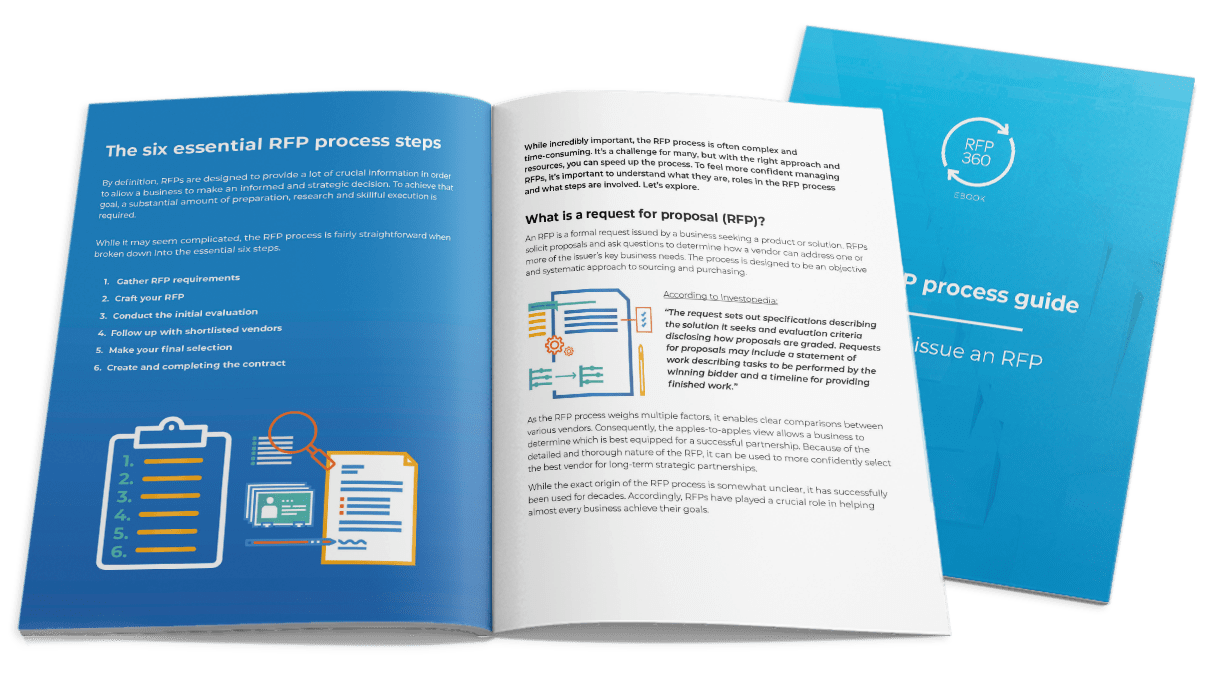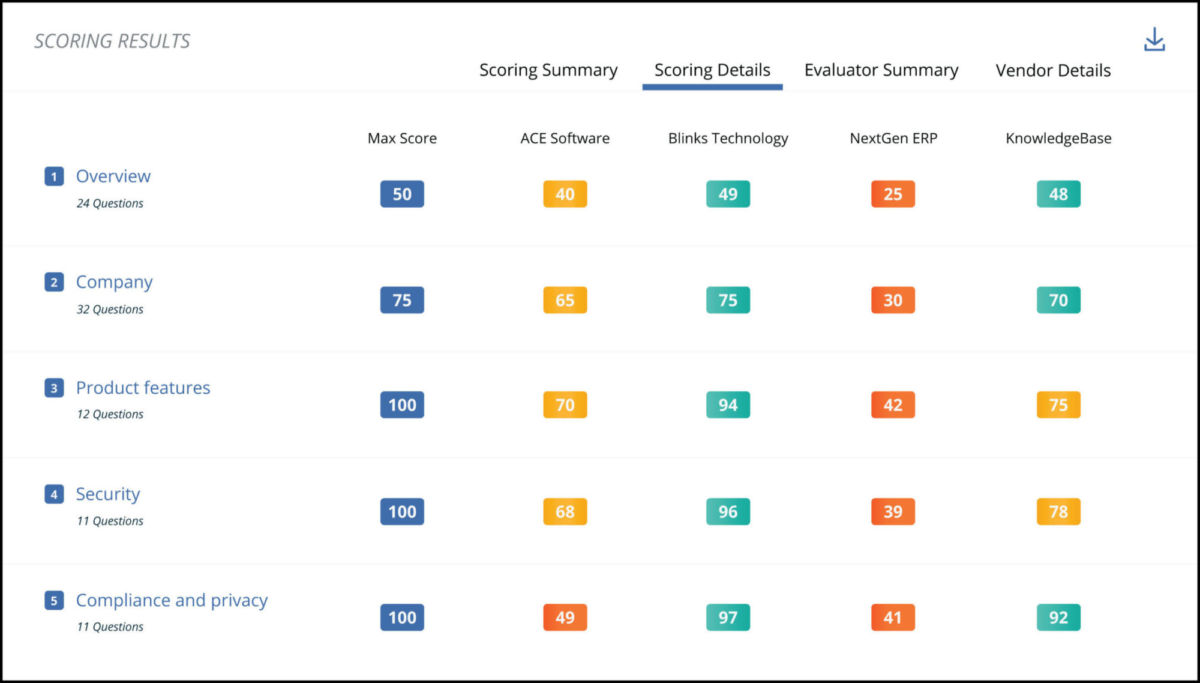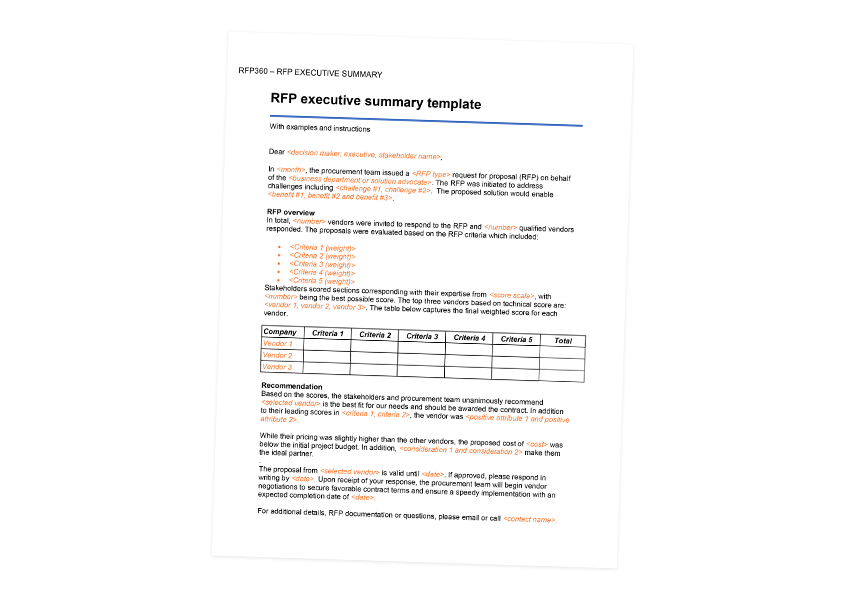Even for the most experienced professionals, writing an executive summary from scratch can be a challenge. After all, you’re responsible for condensing a lot of information into one or two pages. And it’s written for executives and decision makers who will take action based on the information. As part of a procurement project, a request for proposal (RFP) executive summary offers an overview of proposals, recommends the best vendor and seeks final approval to proceed. Accordingly, it must be comprehensive, concise and clear.
Certainly, it’s no easy feat when you’re staring at a blank screen and not sure where to start. So, this blog will explore how RFP issuers use RFP executive summaries as part of the RFP process.
First, we’ll provide the definition and purpose of an executive summary in procurement. Then, we’ll cover how to write an RFP executive summary including an outline, sections to include and how RFP management software can help. Finally, we’ll share RFP executive summary examples and a template to help you get started.
Just need the template? Download a sample RFP executive summary here.
NOTE: If you’re looking to summarize your proposal as part of an RFP response you can download a proposal executive summary template here.
- Executive summary basics: What, why, who and when
- How to write an RFP executive summary
- Sample RFP executive summaries: Examples and templates
Executive summary basics: What, why, who and when
What is an RFP executive summary?
A request for proposal executive summary is a high-level overview of the results of your RFP process.
Sometimes called an RFP brief or RFP summary, it gives a short description of the procurement project, a list of qualified vendors and the RFP scoring results. In addition, the RFP executive summary offers a vendor recommendation and seeks final approval to award a contract to the winner. Ideally, all of this information fits on one page (or two, if you must).
This brief but vital document empowers executive approvers to make an informed decision without having to read each proposal individually.
Why create an RFP executive summary?
Reading, reviewing and scoring proposals from vendors is time consuming. Think about your average RFP. How many questions do you ask? Now, consider how many vendor submissions you usually receive. In all, you may have hundreds of answers spanning dozens of pages.
While RFPs are a necessary part of spend management and risk mitigation, having executives read every word isn’t a good use of their time. Not to mention, waiting for them to find time to get through it isn’t a good use of yours.
Luckily, the RFP executive summary provides a solution. Typically contained on a single page, it enables busy stakeholders to understand the range of vendor options in mere minutes, rather than hours or days. Not only that, but it allows you to reinforce the purpose and goals of the project, highlight the selected vendor’s advantages and justify your recommendations. In addition, the RFP executive summary reassures the decision maker(s) that the process was thorough, data-based and transparent — ideally, leading to speedy approvals.
Who writes the executive summary?
Generally, the primary RFP contact writes the executive summary because they are most familiar with the project, have read the proposals and are responsible for next steps. In practice, that could be a department head, procurement manager or procurement consultant.
When should you write the executive summary?
Not every RFP will require an executive summary. As with any element of lean procurement, you must balance the time required to complete the process with the potential benefits. It’s always best to refer to your procurement policy for guidance. For lower-value purchases, an informal email or meeting may be sufficient to gather the required approvals. On the other hand, it’s wise to create an RFP executive summary to document the decision process for high-value, strategic sourcing projects.

When required, writing the RFP executive summary falls near the end of the procurement cycle. Because it should present an overview of your RFP scoring results and recommend a vendor, you must complete that part of the process before starting.
To explore the entire RFP process in detail, download the ebook: The RFP process guide.

How to write an RFP executive summary
Now that you know some executive summary background including what, why, who and when, let’s talk about how. The goal of any executive summary is to provide just enough information to enable them to quickly understand, make a decision or take action. While brevity is important, you must remember that your decision maker may have no prior knowledge of the project. With this in mind, you can start planning your RFP executive summary by breaking down what needs to be included.
Executive summary outline
- Introduction
- Project summary
- Need statement
- Goals
- Results overview
- Weighted RFP criteria
- Top three vendors
- Scoring recap
- Recommendation
- Winning vendor
- Reason for selection
- Next steps
- Required approvals
- Sign off
Executive summary sections
Introduction
As you might expect, the first part of the executive summary is an introduction to the matter at hand. In an RFP summary, that means offering one or two sentences about the project. Next, provide an overview of the challenges that the purchase will solve. And finally, state the goals and expected outcomes. For example, if you needed to summarize the results of a marketing software RFP, your opening paragraph may look like this:
To whom it may concern,
In <month>, the procurement team (or consultant name) issued a software request for proposal (RFP) on behalf of the marketing team. The RFP was initiated to enable the team to increase next year’s pipeline by automating manual processes, centralizing content and improving overall efficiency.
This paragraph should essentially be the elevator pitch for the purchase. If the department or champion created a business case to gain initial approval, use that document as a guide for your introduction.
Results overview
Next, you’ll need to share a little information about your RFP process and provide a summary of the results. Including this information gives the reader confidence that you’ve done your due diligence.
In total, eight (8) vendors were invited to respond to the RFP and five (5) qualified vendors responded. The proposals were evaluated based on the RFP criteria which included:
-
- Functionality (30%)
- Experience and references (20%)
- Price (20%)
- Approach (15%)
- Misc. considerations (15%)
Stakeholders scored sections corresponding with their expertise from zero to five, with five being the best possible score. The top three vendors are: ABC Company, LMNOP Company and XYZ Company. The table below captures the final weighted score for each vendor.

If you manage RFPs manually using Word or spreadsheets, do your best to create a very brief summary like the one above. On the other hand, if you use RFP management software, you can export a summary of your results to include like this one from RFP360. In addition, you can link to the full report in your executive summary to enable decision-makers to review the results in more detail.

Recommendation
Now, you’ve provided context and reviewed the results, so it’s time to make your recommendation. Hopefully, you have a clear winner and stakeholder consensus. If not, this is your chance to review the proposals again and resolve any stakeholder disagreements.
When stakeholders present a united front, speedy approvals usually follow. While it may seem like a good idea to leave the final decision to the executives, this frequently has less than ideal results. In most cases, the executive approver has spent far less time considering the options so they may delay the process trying to seek clarification. So, be clear and provide an explanation of why you believe the vendor is the right choice. Your vendor recommendation may look something like this:
Based on the scores, the stakeholders and procurement team unanimously recommend ABC Company is the best fit for our needs and should be awarded the contract. In addition to their leading scores in functionality and approach, the vendor was highly responsive and provided positive references from organizations with similar use cases.
While their pricing was slightly higher than the other vendors, the inclusions, benefits and ability to scale with our growth make them the ideal partner. Based on the proposal presented, the total cost for the project is projected to be $10,000.
Next steps
Before signing off, make it clear to the reader what action you need them to take. In addition, share with them your expected milestones for the project.
The proposal from ABC company is valid until <date>. If approved, please respond in writing by <date>. Upon receipt of your response, the procurement team will begin vendor negotiations to secure favorable contract terms and ensure a speedy implementation with an expected completion date of <date>.
Sign off
Time to wrap it up. Sign off by offering assistance and information as needed.
If you have any questions or need additional information about the process or results, please let me know.
Respectfully,
RFP manager, consultant and/or contact
Three tips for effective executive summaries
Address your audience
While the RFP executive summary example above starts with “to whom it may concern” try to avoid that stale greeting. If you know who your final decision maker is, address the summary to them directly.
Be brief
It’s been mentioned before, but it’s absolutely essential — your summary, by definition, should be short. Be concise and accomplish your goal to inform using as little space as possible. Make sure each sentence conveys something crucial. Aim to make your executive summary fit on a single page. In addition, try to make sure it’s easy to scan and understand.
Make sure it can stand alone
Write your executive summary as if the reader has no prior knowledge of your procurement project. The document should be easy to understand on its own. Keep this in mind to avoid getting too far into details and logistics. Outlining high-level results is key. Remember that the executive summary may be the only thing that some key executives read. So make sure you make it count.
RFP executive summary template and examples
As with most writing, starting is the hardest part. If you find yourself frozen, staring at a blank page you might find a sample RFP executive summary helpful. Here you’ll find a template and several real-life examples to give you a head start.
RFP executive summary template
The RFP executive summary example used in the how-to guide above is also available as a template. You can download this executive summary or RFP results and recommendation template in Word and customize it to meet your needs. In addition, the template provides suggestions in the comments with additional direction so anyone can quickly create an impactful executive summary.
RFP evaluation report – Roof replacement RFP
This sample RFP executive summary, called an RFP evaluation report by the writer, summarizes bids from five vendors. In two pages, the document summarizes a complex RFP. Indeed, it includes background information, a summary from the evaluation committee, weighted scoring criteria, a vendor comparison matrix and a final recommendation.
RFP recommendation report – Student information system RFP
At 12 pages, this recommendation report is longer than most RFP executive summaries because it was prepared by a technology procurement consultant who managed the RFP process on behalf of their client. Indeed, it offers details about the RFP process including flow charts and evaluation committee notes. Additionally, you’ll see a cost analysis chart as well as scores after the final vendors gave demonstrations and RFP presentations. Finally, the report also includes a unanimous recommendation signed by all of the RFP evaluation committee members. It makes a compelling case for anyone reading it.
RFP award recommendation – Insurance operations modernization RFP
This award recommendation form serves as an executive summary for an RFP issued by the State of New Jersey. Unlike other RFP executive summary examples, this document starts off with an overview of the bidders and final recommendation. Additionally, it provides a section for justification. If you’re looking for something formal that gets straight to the point, this format is a good option.
RFP summary memorandum – Exchange server RFP
In this memorandum, you’ll find a two-page summary of the Village of North Aurora’s search for a new exchange email server. Fortunately for the RFP issuer, the staff found a clear front runner that not only met the technical requirements, but also came in under budget. In addition to the RFP summary and recommendation, you’ll see the RFP itself provided as an attachment.
The value of an executive summary
Creating the perfect executive summary is a never-ending process. Indeed, each one is a little different. However, as your experience grows, evolves and improves, so too will the quality your executive summaries.



